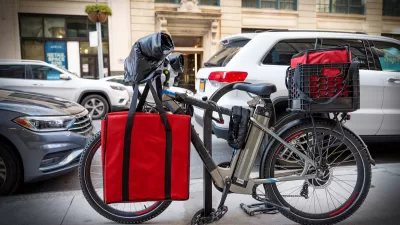Cargo bike producers and delivery companies say the proposed 120-inch length limit and emphasis on four-wheeled bikes excludes many commonly used delivery bikes and favors one manufacturer.

When the New York City Department of Transportation (NYCDOT) announced a proposed rule revision that would make way for larger cargo bikes in the city, bike advocates hailed it as a victory. But freight industry leaders say the change would outlaw some of the most common delivery bikes and skew the market toward one particular manufacturer, writes Gersh Kuntzman in Streetsblog NYC.
The new rules would explicitly allow four-wheeled, pedal-assist cargo bikes—just the kind that the city’s Department of Transportation is testing. But, as Kuntzman explains, “Those bikes are made by Fernhay, which is owned by a well-connected lawyer, William Wachtel.”
Kuntzman points out that “Industry leaders who were not Wachtel believe that the well-connected lawyer has some undue influence over the Adams administration — though such speculation is common when one company’s design is chosen over others’.”
According to Ben Morris of Boaster Cycles, “The 120-inch cap is going to eliminate all bike-and-trailer cargo solutions that currently operate in the market today and in the future.” The CEO of Net Zero Logistics said, “the suggested limit of 120 inches will force us to shut down, completely reengineer our operations or return to using vans for delivery.”
NYCDOT will hold just one public hearing on the issue on September 13.
FULL STORY: Industry Leaders Slam DOT’s Proposed Cargo Bike Rules

Alabama: Trump Terminates Settlements for Black Communities Harmed By Raw Sewage
Trump deemed the landmark civil rights agreement “illegal DEI and environmental justice policy.”

Planetizen Federal Action Tracker
A weekly monitor of how Trump’s orders and actions are impacting planners and planning in America.

The 120 Year Old Tiny Home Villages That Sheltered San Francisco’s Earthquake Refugees
More than a century ago, San Francisco mobilized to house thousands of residents displaced by the 1906 earthquake. Could their strategy offer a model for the present?

In Both Crashes and Crime, Public Transportation is Far Safer than Driving
Contrary to popular assumptions, public transportation has far lower crash and crime rates than automobile travel. For safer communities, improve and encourage transit travel.

Report: Zoning Reforms Should Complement Nashville’s Ambitious Transit Plan
Without reform, restrictive zoning codes will limit the impact of the city’s planned transit expansion and could exclude some of the residents who depend on transit the most.

Judge Orders Release of Frozen IRA, IIJA Funding
The decision is a victory for environmental groups who charged that freezing funds for critical infrastructure and disaster response programs caused “real and irreparable harm” to communities.
Urban Design for Planners 1: Software Tools
This six-course series explores essential urban design concepts using open source software and equips planners with the tools they need to participate fully in the urban design process.
Planning for Universal Design
Learn the tools for implementing Universal Design in planning regulations.
Clanton & Associates, Inc.
Jessamine County Fiscal Court
Institute for Housing and Urban Development Studies (IHS)
City of Grandview
Harvard GSD Executive Education
Toledo-Lucas County Plan Commissions
Salt Lake City
NYU Wagner Graduate School of Public Service





























